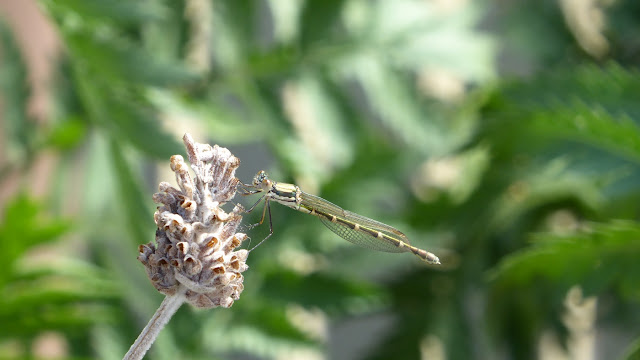A damselfly resting among my French Lavender.
Latest Update 24th March 2017.
Damselfly.
- The general body plan of a damselfly is similar to that of a dragonfly, but its compound eyes are widely separated and they are smaller than their usually much larger distant cousins.
- The first thoracic
segment bears the front pair of legs. The joint
between the head and this segment is slender and flexible, which enables the
damselfly to swivel its head and manoeuvre more freely when flying.
The remaining thoracic segments are fused together,
each supporting a pair of wings and a pair of legs. A dark stripe runs from the base of the front wings to the second
pair of legs, and just in front of this is a pale-coloured stripe.
- The forewings and hindwings are similar in appearance and are
membranous, being strengthened and supported by longitudinal veins that
are linked by many cross-veins.
- Most damselfly females have pale translucent greenish wings and light coloured bodies. The males have darker green bodies and large dark violet-blue
patches on all four wings, which flicker conspicuously in their aerial
courtship dances.
- Damselflies
rest their wings together, above their bodies when resting, whereas dragonflies spread their wings diametrically apart. Damselflies have slenderer bodies than
dragonflies, and their eyes do not overlap. Damselfly nymphs differ from
dragonfly nymphs as they possess caudal gills (on the abdomen)
whereas dragonflies breathe through the rectum. Damselfly nymphs swim with
fish-like undulations, the gills functioning like a tail. Dragonfly
nymphs can forcibly expel water from their rectum for rapid escapes.
- Adult damselflies catch and eat flies, mosquitoes, and other small
insects. Often they hover among grasses and low vegetation, picking prey
off stems and leaves with their spiny legs. Although predominantly using vision to locate their prey, adults may also make use of olfactory cues.
- Damselflies exist in a range of habitats in and around the wetlands
needed for their larval development; these include open spaces for
finding mates, suitable perches, open aspect, roosting sites, suitable
plant species for ovipositing and suitable water quality.
- Damselflies' dependence on freshwater habitats makes them very
vulnerable as wetlands are damaged by draining for agriculture or
urban growth.
In my Garden.
- Damselflies are welcome visitors to my garden. They appear from time to time in summer to feed on small insects, and I regard their presence as an endorsement of the biodiversity which exists there.
- They breed and feed mainly in the wetlands adjoining a small creek that runs though our suburb.
Information from.
| |
|
|

No comments:
Post a Comment